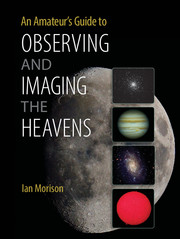Book contents
- Frontmatter
- Dedication
- Contents
- Preface
- Acknowledgements
- Prologue A Tale of Two Scopes
- 1 Telescope and Observing Fundamentals
- 2 Refractors
- 3 Binoculars and Spotting Scopes
- 4 The Newtonian Telescope and Its Derivatives
- 5 The Cassegrain Telescope and Its Derivatives
- 6 Telescope Maintenance, Collimation and Star Testing
- 7 Telescope Accessories
- 8 Telescope Mounts
- 9 The Art of Visual Observing
- 10 Visual Observations of the Moon and Planets
- 11 Imaging the Moon and Planets
- 12 Observing and Imaging the Sun
- 13 Observing and Imaging with an Astro-Video Camera
- 14 DSLR Deep-Sky Imaging
- 15 Imaging with Cooled CCD Cameras
- 16 Auto-Guiding and Drift Scan Alignment
- 17 Spectral Studies
- 18 Improving and Enhancing Images in Photoshop
- Index
- Plate Section
2 - Refractors
Published online by Cambridge University Press: 05 June 2014
- Frontmatter
- Dedication
- Contents
- Preface
- Acknowledgements
- Prologue A Tale of Two Scopes
- 1 Telescope and Observing Fundamentals
- 2 Refractors
- 3 Binoculars and Spotting Scopes
- 4 The Newtonian Telescope and Its Derivatives
- 5 The Cassegrain Telescope and Its Derivatives
- 6 Telescope Maintenance, Collimation and Star Testing
- 7 Telescope Accessories
- 8 Telescope Mounts
- 9 The Art of Visual Observing
- 10 Visual Observations of the Moon and Planets
- 11 Imaging the Moon and Planets
- 12 Observing and Imaging the Sun
- 13 Observing and Imaging with an Astro-Video Camera
- 14 DSLR Deep-Sky Imaging
- 15 Imaging with Cooled CCD Cameras
- 16 Auto-Guiding and Drift Scan Alignment
- 17 Spectral Studies
- 18 Improving and Enhancing Images in Photoshop
- Index
- Plate Section
Summary
In the nineteenth and early twentieth centuries, every ‘gentleman astronomer’ would have had a 3½-inch (90-mm) brass refractor with a focal length of 42 inches (1,080 mm) and so a focal ratio of 12. Indeed, I have one myself, though I would not claim to be a gentleman! They may have had a 6-inch (150-mm) Newtonian telescope as well. But as Newtonians with larger apertures became available and as more emphasis was put on deep-sky observing, refractors went out of fashion. Over the past 30 years, however, they have had a renaissance as improved glasses and computer-aided design have made available refractors that can give exquisite images of the planets, whilst those of shorter focal lengths give wonderful wide-field views of open clusters and the Milky Way. I really do feel that every amateur astronomer should have one.
The Dutchman Hans Lippershey, a spectacle maker, is generally credited with the design of the simple refracting telescope, which uses two lenses to create a magnified image of a distant object, although it is unclear if he actually invented it. He applied for a patent in 1608 but did not receive one, as there were several claims made by other spectacle makers. In Italy, Galileo Galilei heard of the device and carried out experiments to find the optimum design of the singlet objective lens. His empirical design of a biconvex lens with differing radii of curvature was almost exactly that which would be designed now by ray tracing methods. He used his telescopes, whose magnifications ranged up to 30, to observe the Moon and planets and discovered what are now known as the four Galilean moons of Jupiter. He observed that Venus could show almost full phases during part of its orbit and realised that this could happen only if Venus passed beyond the Sun, thus showing that Venus orbits the Sun, not the Earth, and so proving the Copernican model of the solar system.
- Type
- Chapter
- Information
- An Amateur's Guide to Observing and Imaging the Heavens , pp. 30 - 45Publisher: Cambridge University PressPrint publication year: 2014
- 2
- Cited by



